In layman's terms, GST is a single tax that would be imposed throughout the nation, replacing a variety of existing taxes collected by the Central and State Governments. Eventually, this will lower production costs and establish a shared market across state borders.
GST developed progressivity via different rate slabs, where things purchased by an elite class of customers would have a higher tax rate, whilst commodities consumed by the general public would have a lower tax rate. The GST has been implemented methodically and phased to absorb the expected risk of increased inflation and a slower growth rate.
A Quick Overview of GST:
• Indirect taxes such as VAT, Central Sales Tax, Purchase Tax, Sales Tax, Excise duty, CAD, SAD, Octree, Entry Tax, Luxury Tax, cases, and so on are replaced with a single tax known as GST.
• Under GST, there is a dual system of taxation (Central + State), which implies that tax is collected by both the State and the Central Government.
• Automobiles, Logistics, Cement, FMCG, Pharmaceutical, E-commerce, and Industry Manufacturing are among the GST gainers.
• Media, textiles, banks, and telecommunications are among the GST-losing industries.
• Human consumption of alcohol; petroleum goods such as gasoline, high-speed diesel, petroleum crude, natural gas, and aviation turbine fuel; and electricity are exempt from GST.
• GST is a streamlined tax scheme that applies to goods and services at a consistent rate throughout the country.
• It is India's most significant indirect tax reform, providing a consistent and transparent approach to indirect taxation.
• GST rates are set at 0%, 5%, 12%, 18%, and 28%.
Let us look at a few instances better to understand the effect of GST on different sectors:
1. Domestic Sector:
Food goods are subject to a 0-5% GST tax rate, which has no direct influence on food costs. Cosmetic services, such as salon and beauty services, are known to become more costly due to an additional 3% GST rate and no advantage from an input tax credit on such services.
The advent of the Goods and Services Tax (GST) regime has increased the cost of daily household products since the user, as the ultimate consumer, cannot pass on the tax burden further, resulting in price increases.
2. Automobile Industry:
With the addition of GST, certain automobile costs fell significantly, while others rose. Many vehicle manufacturers reduced the pricing of their models. With an extra cess of 1% to 15%, purchasing a vehicle would now attract 28% of the GST rate.
Cars with diesel engines less than 1,500 cc will be subject to a 3% tax. Small automobiles with petrol engines under 1200 cc will be subject to a 1% tax. Large automobiles and SUVs with a length of more than 4 metres will be subject to a 28% GST and a 15% cess.
Electric cars will be subject to 12% GST, but no cess will be collected. No Cess will be levied on ambulances, three-wheelers, or motorcycles with engines less than 350 cc.
3. Actual Estate:
There will be several conditions if a consumer purchases an under-construction home for INR 1 crore. Previously, it was roughly 5.5 per cent VAT and service tax applicable. However, the 12% tax rate applicable to real estate under GST makes it significantly more costly.
If given over before possession, there will be no adjustments to the ready-to-move flats with a completion certificate. No money has been received as a consideration in advance, giving it the character of a sale of goods as they have been kept out of the GST scope as discussed in Schedule III of Section 7 (Supply) of the CGST Act 2017.
4. Clothing and Footwear:
Garments and make-up products are less expensive after GST. Garments and make-up products priced below Rs 1,000 per piece will now be subject to a 5% GST charge. At the same time, clothing and made-up goods priced over Rs1,000 per piece would be subject to a 12% GST charge.
5. Taxi and Cab Services:
Suppose a consumer gets a cab for 100 rupees. In that case, there will be a significant shift in the tax since before, there was roughly 6% of service tax, but under the GST, it is now collected at 5%, resulting in marginal savings for the customer.
6. Airline Travel:
If a consumer plans a domestic economy class flight in India for INR 1000, the tax rate varies in both circumstances. Previously, the home economy class was subject to a 6% service tax; however, under the GST, the economic class is taxed at 5%, resulting in little savings.
Regarding the business class, the GST tax rate has been raised from 9% to 12%, resulting in a costly business-class tax case.
7. Jewellery:
Following the implementation of the GST, the tax rate is raised by 1%, rising from 2% to 3%. Gold investment has grown more costly since buyers must now pay 3% GST on gold and 5% on making costs.
8. Mobile Billing:
The burden on mobile phone consumers has grown as a result of GST. Due to a 3% rise in the tax rate (15% to 18%), both pre-paid and post-paid consumers would have to pay higher bills.
9. Restaurants:
A consumer who purchases dinner for INR 1000 will save significantly on the restaurant charge. In the previous tax plan, there was VAT at 12.5% and service tax at 6%, for a total of about 18.5%.
While under GST, all freestanding restaurants (AC or non-AC) were taxed at 5% without the benefit of ITC, resulting in a cost decrease in the restaurant bill.




 Table of Contents
Table of Contents

 Home Loans
Home Loans
 Personal
Loans
Personal
Loans
 SME Loans
SME Loans
 Business Loans - Udyog
Plus
Business Loans - Udyog
Plus
 Loan against Securities
Loan against Securities
 Mutual Funds
Mutual Funds
 Stock and
Securities
Stock and
Securities
 Portfolio
Management Services
Portfolio
Management Services
 Pension Funds
Pension Funds
 Life
Insurance
Life
Insurance
 Health
Insurance
Health
Insurance
 Wellness
Solutions
Wellness
Solutions
 Pay Bills
Pay Bills
 Pay anyone
Pay anyone
 Pay on call
Pay on call
 Payment
Lounge
Payment
Lounge
 ABC Credit
Cards
ABC Credit
Cards

 1800-270-7000
1800-270-7000










